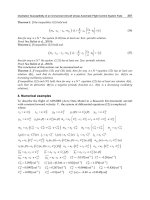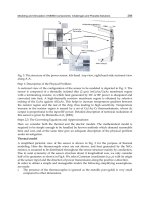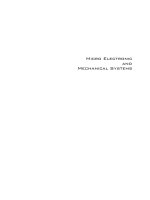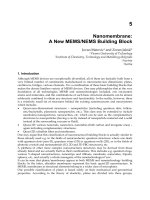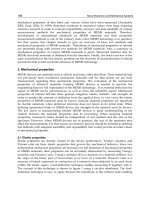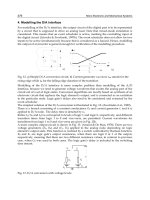Dynamics of Mechanical Systems 2009 Part 16 ppt
Bạn đang xem bản rút gọn của tài liệu. Xem và tải ngay bản đầy đủ của tài liệu tại đây (412.97 KB, 27 trang )
732 Dynamics of Mechanical Systems
P20.4.2: See Problem P20.4.1. Construct a table analogous to Table 20.4.1 for the hand
model, showing the body numbers, the body names, the generalized speeds, and the
variable names.
Section 20.5 Kinematics: Velocities and Accelerations
P20.5.1: Review the analysis of Section 20.5 relating to the example for the kinematics of
the right hand. Develop an analogous analysis for the kinematics of the right foot.
P20.5.2: See Problems P20.3.1, P20.3.2, P20.4.1, and P20.4.2. Consider again the model of
the hand shown in Figure 20.2.3 and again in Figure P20.4.1. Develop the kinematics of
the hand model analogous to the gross-motion development in Section 20.5.
Section 20.6 Kinetics: Active Forces
P20.6.1: Consider a simple planar model of the arm as shown in Figure P20.6.1. It consists
of three bodies representing the upper arm, the forearm, and the hand, labeled and
numbered as 1, 2, and 3, respectively, as shown. Let the shoulder, elbow, and wrist joints
be O
1
, O
2
, and O
3
, respectively. Let the lengths of the bodies be ᐉ
1
, ᐉ
2
, and ᐉ
3
; let the
weights of the bodies be w
1
, w
2
, and w
3
; and let the mass centers each be one third of the
body length distal from the upper joint. Let the hand support a mass with weight W at
the finger tips as shown. Finally, let the orientation of the bodies be defined by the relative
angles β
1
, β
2
, and β
3
. If O
1
is a fixed point in a reference frame R, develop the kinematics
of this system using β
1
, β
2
, and β
3
as generalized coordinates.
P20.6.2: See Problem P20.6.1. Determine the contribution to the generalized active forces
of the weights of the bodies.
P20.6.3: See Problem P20.6.1. Determine the contribution to the generalized active forces
of the weight of the mass at the finger tips.
FIGURE P20.4.1
A model of the human hand.
FIGURE P20.6.1
A model of the arm.
n
W
O
1
2
3
β
β
β
O
O
n
1
1
2
2
3
3
O1
O2
0593_C20_fm Page 732 Tuesday, May 7, 2002 9:14 AM
Application with Biosystems, Human Body Dynamics 733
P20.6.4: See Problem P20.6.1 and Figure P20.6.1. Let the movement of the system be defined
by the absolute angles θ
1
, θ
2
, and θ
3
as in Figure P20.6.4. Repeat Problems P20.6.1, P20.6.2,
and P20.6.4 using θ
1
, θ
2
, and θ
3
as generalized coordinates.
Section 20.7 Kinetics: Muscle and Joint Forces
P20.7.1: See Problems P20.6.1 to P20.6.4. Let the forces exerted between the bodies due to
the muscles be equivalent to and represented by single forces passing through the joint
centers together with couples. For example, at a typical joint — say, the elbow (joint 2) —
let the muscle forces exerted by B
1
(the upper arm) on B
2
(the forearm) be represented by
a single force F
1/2
passing through O
2
together with a couple with torque M
1/2
. Similarly,
let the muscle forces exerted by the forearm on the upper arm be represented by a single
force F
2/1
passing through O
2
together with a couple with torque M
2/1
. Let these forces
and moments be negative to one another; that is,
Determine the contribution of the muscle forces to the generalized active forces using both
the relative angles β
1
, β
2
, and β
3
and the absolute angles θ
1
, θ
2
, and θ
3
as generalized
coordinates.
Section 20.8 Kinetics: Inertia Forces
P20.8.1: Verify again the validity of Eq. (20.8.11).
P20.8.2: Consider again the model of the arm of Problem P20.6.1 shown in Figure P20.6.1
and as shown again in Figure P20.8.2. Let the bodies be modeled by frustrums of cones
and let mutually perpendicular unit vectors n
ki
(k = 1, 2, 3; i = 1, 2, 3) be fixed in the bodies
with the n
k2
being along the axes of the bodies (and cones) and the n
k3
being normal to
the plane of motion. Let the n
ki
be parallel to principal inertia axes of the bodies, and let
the corresponding moments and products of inertia then be:
Determine the generalized inertia forces on the system.
FIGURE P20.6.4
A model of the arm with absolute
orientation angles.
n
W
O
1
2
3
O
O
n
1
1
2
2
3
3
O1
O2
θ
θ
θ
FF MM
12 21 12 21
=− =−and
IIIII
III
kk
k
k
k
kkk
11 33
3
22
2
12 13 23
0
== =
===
() ()
,
0593_C20_fm Page 733 Tuesday, May 7, 2002 9:14 AM
734 Dynamics of Mechanical Systems
P20.8.3: See Problems P20.6.4 and P20.8.2. Let the movement of the arm model be defined
by the absolute angles θ
1
, θ
2
, and θ
3
as shown in Figure P20.6.4 and as shown again in
Figure P20.8.3. Find the generalized inertia forces corresponding to θ
1
, θ
2
, and θ
3
using
the inertia data of Problem P20.8.2.
Section 20.9 Dynamics, Equations of Motion
P20.9.1: See Problems P20.6.1, P20.6.2, P20.6.3, P20.7.1, and P20.8.2. Using the results
obtained in these problems, determine the governing equations of motion for the arm
model using the relative orientation angles β
1
, β
2
, and β
3
as generalized coordinates.
P20.9.2: See Problems P20.6.4, P20.7.1, and P20.8.3. Using the results obtained in these
problems, determine the governing equations of motion for the arm model using the
absolute orientation angles θ
1
, θ
2
, and θ
3
as generalized coordinates.
Section 20.10 Constrained Motion
P20.10.1: See Problems P20.9.1 and P20.9.2. Let the finger tips (extremity of body 3) have
a desired motion — say, movement on a circle at constant speed v (let the circle be in
the vertical plane with center (x
O
, y
O)
and with radius a). Determine the governing
equations of motion for the model with this constraint. Use both relative and absolute
orientation angles.
FIGURE P20.8.2
A model of the arm.
FIGURE P20.8.3
A model of the arm with absolute
orientation angles.
0593_C20_fm Page 734 Tuesday, May 7, 2002 9:14 AM
735
Appendix I*
Centroid and Mass Center Location for Commonly
Shaped Bodies with Uniform Mass Distribution
I. Curves, wires, thin rods
1. Straight line, rod:
2. Circular arc, circular rod:
3. Semicircular arc, semicircular rod:
* Reprinted from Huston, R. L., and Liu, C. Q.,
Formulas for Dynamic Analysis
, pp. 303–310, by courtesy of
Marcel Dekker, New York, 2001.
0593__App I_fm Page 735 Tuesday, May 7, 2002 9:21 AM
736
Dynamics of Mechanical Systems
4. Circle, hoop:
II. Surfaces, thin plates, shells
1. Triangle, triangular plate:
2. Rectangle, rectangular plate:
x = (a + b)/3
y = c/3
0593__App I_fm Page 736 Tuesday, May 7, 2002 9:21 AM
Appendix I
737
3. Circular sector, circular section plate:
4. Semicircle, semicircular plate:
5. Circle, circular plate:
r
-
= (2r/3) (sin
θ
)/
θ
r
-
= 4r/
Π
0593__App I_fm Page 737 Tuesday, May 7, 2002 9:21 AM
738
Dynamics of Mechanical Systems
6. Circular segment, circular segment plate:
7. Cylinder, cylindrical shell:
8. Semicylinder, semicylindrical shell:
r
-
= (2r/3) (sin
3
θ
)/(
θ
– sin
θ
cos
θ
)
0593__App I_fm Page 738 Tuesday, May 7, 2002 9:21 AM
Appendix I
739
9. Sphere, spherical shell:
10. Hemisphere, hemispherical shell:
11. Cone, conical shell:
0593__App I_fm Page 739 Tuesday, May 7, 2002 9:21 AM
740
Dynamics of Mechanical Systems
12.Half cone, half-conical shell:
III Solids, bodies
1. Parallelepiped, block:
2. Cylinder:
3. Half cylinder:
0593__App I_fm Page 740 Tuesday, May 7, 2002 9:21 AM
Appendix I
741
4. Cone:
5. Half cone:
6. Sphere:
7. Hemisphere:
0593__App I_fm Page 741 Tuesday, May 7, 2002 9:21 AM
0593__App I_fm Page 742 Tuesday, May 7, 2002 9:21 AM
743
Appendix II*
Inertia Properties (Moments and Products of Inertia)
for Commonly Shaped Bodies with Uniform Mass
Distribution
I. Curves, wires, thin rods
1. Straight line, rod:
2. Circular arc, circular rod:
* Reprinted from Huston, R. L., and Liu, C. Q.,
Formulas for Dynamic Analysis
, pp. 303–310, by courtesy of
Marcel Dekker, New York, 2001.
I
11
= 0
I
22
= ML
2
/12
r
-
= (rsin
θ
)/
θ
I
11
= mr
2
(1 + sin2
θ
/2
θ
– 2sin
2
θ
/
θ
2
)/2
I
22
= mr
2
(1 – sin2
θ
/2
θ
)/2
0593__AppII_fm Page 743 Tuesday, May 7, 2002 9:21 AM
744
Dynamics of Mechanical Systems
3. Semicircular arc, semicircular rod:
4. Circle, hoop:
I
11
= mr
2
(1 – 8/
Π
2
)/2
I
22
= mr
2
r
-
= 2r/
Π
I
11
= mr
2
/2
0593__AppII_fm Page 744 Tuesday, May 7, 2002 9:21 AM
Appendix II
745
II. Surfaces, thin plates, shells
1. Triangle, triangular plate:
2. Rectangle, rectangular plate:
x = (a + b)/3
y = c/3
I
11
= mc
2
/18
I
22
= m(b
2
– ab + a
2
)/18
I
12
= mc(2a – b)/18
I
11
= ma
2
/12
I
22
= mb
2
/12
0593__AppII_fm Page 745 Tuesday, May 7, 2002 9:21 AM
746
Dynamics of Mechanical Systems
3. Circular sector, circular section plate:
4. Semicircle, semicircular plate:
r
-
= (2r/3) (sin
θ
)/
θ
I
11
= (mr
2
/4) (1 + sin
θ
cos
θ
/
θ
– 16sin
2
θ
/9
θ
2
)
I
22
= (mr
2
/4) (1 – sin
θ
cos
θ
/
θ
)
r
-
= 4r/3
Π
I
11
= mr
2
(9
Π
2
– 64)/36
Π
2
I
22
= mr
2
/4
0593__AppII_fm Page 746 Tuesday, May 7, 2002 9:21 AM
Appendix II
747
5. Circle, circular plate:
6. Circular segment, circular segment plate:
I
11
= mr
2
/4
r
-
= (2r/3) (sin
3
θ
)/(
θ
– sin
θ
cos
θ
)
I
11
= mr
2
(9
θ
2
+ 9sin
2
θ
cos
2
θ
– 36sin
4
θ
cos
4
θ
– 18
θ
sin
θ
cos
θ
+ 36sin
3
θ
cos
θ
–
8sin
6
θ
)/18(
θ
– sin
θ
cos
θ
)
2
I
22
= mr
2
[1 – 2sin
3
θ
cos
θ
/3(
θ
– sin
θ
cos
θ
)]/4
0593__AppII_fm Page 747 Tuesday, May 7, 2002 9:21 AM
748
Dynamics of Mechanical Systems
7. Cylinder, cylindrical shell:
8. Semicylinder, semicylindrical shell:
9. Sphere, spherical shell:
I
11
= mr
2
I
22
= m(6r
2
+ L
2
)/12
I
11
= mr
2
(1 – 4/
Π
2
)
I
22
= m(r
2
+ L
2
/6)/2
I
33
= mr
2
(1/2 – 4/
Π
2
) + mL
2
/12
I
11
= 2mr
2
/3
0593__AppII_fm Page 748 Tuesday, May 7, 2002 9:21 AM
Appendix II
749
10.Hemisphere, hemispherical shell:
11. Cone, conical shell:
12.Half cone, half-conical shell:
r
-
= 3r/8
I
11
= 2mr
2
/3
I
22
= 5mr
2
/12
I
11
= mr
2
/2
I
22
= m(r
2
/2 + h
2
/9)/2
I
11
= mr
2
(1 – 8/9
Π
2
)/2
I
22
= (m/36) (9r
2
+ 2h
2
)
I
33
= mh
2
/18 + mr
2
(1 – 16/9Π
2
)/4
I
12
= –mrh/9Π
0593__AppII_fm Page 749 Tuesday, May 7, 2002 9:21 AM
750 Dynamics of Mechanical Systems
III. Solids, bodies
1. Parallelepiped, block:
2. Cylinder:
I
11
= m(a
2
+ c
2
)/12
I
22
= m(b
2
+ c
2
)/12
I
33
= m(a
2
+ b
2
)/12
I
11
= mr
2
/2
I
22
= mr
2
/4 + mL
2
/12
0593__AppII_fm Page 750 Tuesday, May 7, 2002 9:21 AM
Appendix II 751
3. Half cylinder:
4. Cone:
5. Half cone:
I
11
= mr
2
(9 – 32/Π
2
)/18
I
22
= m(3r
2
+ L
2
)/12
I
33
= mL
2
/12 + mr
2
(9 – 64/Π
2
)/36
I
11
= 3mr
2
/10
I
22
= 3m(4r
2
+ h
2
)/80
I
11
= mr
2
(3/10 - 1/Π
2
)
I
22
= 3m(4r
2
+ h
2
)/80
I
33
= mr
2
(3/20 – 1/Π
2
) + 3mh
2
/80
I
12
= –mrh/20Π
0593__AppII_fm Page 751 Tuesday, May 7, 2002 9:21 AM
752 Dynamics of Mechanical Systems
6. Sphere:
7. Hemisphere:
I
11
= 83mr
2
/320
I
22
= 2mr
2
/5
0593__AppII_fm Page 752 Tuesday, May 7, 2002 9:21 AM
753
Index
A
Absolute orientation angles, 142
Acatastatic system, 690
Acceleration, 5, 59, 66
Accident reconstruction, 338
Action–reaction, 181, 241
Active forces, 2, 177, 244, 379, 647, 677, 715
Addendum, 581, 599
Addition theorem for angular velocity, 90
Adjoining bodies, 609
Adjoint, 40
Amplitude, 440
Angle, 9
Angle between two vectors, 23, 28
Angle of action, 584, 599
Angle of approach, 584, 599
Angle of contact, 584, 599
Angular acceleration, 83, 93, 640
Angular impulse, 280
Angular momentum, 282
Angular speed, 83
Angular velocity, 9, 83, 85, 635, 667
Anticyclic indices, 30
Antisymmetric matrix, 39
Applied forces, 177, 677
Articulation angles, 662, 688
Associative law, 18, 40
Axial pitch, 599
B
Backlash, 582, 599
Balancing, 513
Ball-and-socket joint, 4
Base circle, 578, 599
Basic rack, 591
Bevel gears, 596, 599
Biceps, 716, 717
Biosystem, 701
Boltzmann-Hamel equations, 242, 243
Branching body, 608
Buridan, John, 241
C
Cam-pair, 539
Cam profiles, 544
Cams, 5, 15, 539
Cam systems, 3
Cartesian coordinate system, 6, 8
Center of percussion, 298
Centroid, 735
Chord vector, 60
Circular frequency, 440
Circular pitch, 582, 599
Clearance, 583, 599
Closed loops, 606
Coefficient of restitution, 303
Column matrix, 39
Commutative law, 16, 23
Complete elliptic integral, 462
Components of vectors, 16, 19
Compression stroke, 529
Configuration graphs, 79, 614, 664
Conformable matrix, 39
Conjugate action, 575, 600
Connection configuration, 605
Conservation of momentum, 294, 301
Constrained motion, 722
Constraint equations, 125, 126, 684
Constraint forces, 684
Constraint matrix, 683
Constraints, 3, 125, 353
Contact forces, 180
Contact ratio, 585, 600
Coordinates, 6, 125, 353, 628
Couples, 170
Cross product, 29
Cyclic indices, 30
Cycloidal rise function, 563
Cylindrical coordinate system, 7
D
d’Alembert’s principle, 185, 242, 243, 262, 279, 290
Damped linear oscillator equation, 442
Dedendum, 581, 600
Degrees of freedom, 3, 125, 353, 628, 661
Derivative of transformation matrices, 612, 668
754
Dynamics of Mechanical Systems
Determinant, 40
Dextral rotation, 43
Dextral vectors, 30
Diagonal matrix, 39
Diametral pitch, 583
Dirac’s delta function, 554
Directed line segment, 5
Direct impact, 306
Direction cosines, 21
Direction of a vector, 5
Distributive law, 17, 25, 32, 40
Dot product, 23
Double-rod pendulum, 258, 381, 396, 418, 426
Driver, 3, 539
Driver gear, 574
Dwell, 542
Dyad, 203
Dyadic, 203
Dynamic balancing, 514
Dynamics, 1
Dynamic unbalance, 516
E
Earth rotation effect, 89
Eigen unit vector, 209
Eigenvalue of inertia, 209
Elastic collision, 304
Elements of a matrix, 39
Elliptic integral 460
End effector, 661, 674, 692, 698
Ending body, 607-608
Energy, 9, 10
Equality of vectors, 15
Equivalent force systems, 170
Euler angles, 82
Euler parameters, 613, 707-709
Euler torque, 230
Exhaust stroke, 529
Extremity body, 607
F
Fillet radius, 583
Finite segment model, 142
Firing order of internal combustion engines, 530
First integral, 459
First moments, 182
Fixed stars, 244
Fixed vector, 15
Follower, 3, 539
Follower gear, 574
Force, 2, 5, 9, 163
Forced vibration, 446, 449
Forcing function, 442
Four-bar linkage, 136
Four-stroke engines, balancing of, 528
Free-body diagram, 245-246
Free index, 38
Free vector, 15
Frequency, 440
G
Gear drive, 592
Gear glossary, 599-601
Gears, 539, 573
Gear systems, 3
Gear train, 592
Generalized active force, 363
Generalized applied force, 363
Generalized coordinates, 242, 353
Generalized forces, 360
Generalized inertia forces, 360, 377
Generalized passive force, 377
Generalized speeds, 628
General plane motion, 129, 130
Gibbs equations, 243
Gibbs function, 243
Gravity forces, 177
Gripper, 661
Gross-motion model, 702
H
Hamilton’s principle, 242
Helical gears, 595
Helix joint, 4
Holonomic constraint, 357
Human body dynamics, 702
Human body model, 704
Hypoid gears, 597
I
Identity matrix, 39
Imbalance, 513
Impact, 303
Impulse, 279
Impulse-momentum, 242
Incomplete elliptic integral, 462
Inertia, 1, 2, 199, 241
Inertia coefficients, 651
Inertia ellipsoid, 228
Inertia forces, 177, 184, 243, 244, 248, 648, 680, 719
Inertial reference frame, 2, 185, 244
Inertia properties (common shapes), 743
Inertia torque, 228, 249-250
Infinitesimal stability, 479
Inside unit vector, 80
Instant center of zero acceleration, 150
Instant center of zero velocity, 133, 147
Index
755
Intake stroke, 529
Integration algorithms, 688
Intermediate body, 608
Inverse matrix, 40
Involute curve, 578
Involute function, 579-581
Involute rack, 591
J
Joint, 3
Joint forces, 716
Jourdain’s principle, 243
K
Kane’s equations, 242, 243, 263, 415, 422, 435
Kane, T. R., 416, 460
Kinematic chain, 4
Kinematics, 1, 2, 57, 241
Kinetic energy, 327
Kinetics, 163, 241
Kronecker’s delta function, 24, 38, 42
Krylov and Bogoliuboff method, 463
L
Lagrange multiplier, 224
Lagrange’s equations, 242, 262, 423, 435
Lagrange’s form of d’Alembert’s principle, 243, 416
Lagrangian, 242, 424
Lanchester balancing mechanism, 525
Law of action and reaction, 717
Law of conjugate action, 576
Linear impulse, 279
Linear momentum, 280
Linear oscillator equation, 246, 439
Linear rise function, 551
Line of action, 578
Line of centers, 585
Line of contact, 584
Link, 3
Linkage, 3
Logarithmic decrement, 471
Loop closure equation, 137
Lower body arrays, 605
M
Machine, 3
Magnitude of a vector, 5, 15, 27
Mass, 2, 10, 241
Mass center, 177
Mass center locations (common shapes), 735
Mass density, 10
Mass-spring system, 336
Matrix, 39
Matrix inverse, 40
Maximum moment of inertia, 223
Mechanism, 3
Mesh, 575
Minimum moment of inertia, 223
Minimum moments, 175
Minor, 40
Mobile robot, 661
Modes of vibration, 455
Module, 583
Moment, 10, 163
Moment of inertia, 200, 743
Moment of momentum, 282
Momentum, 280
Motion on a circle, 66
Motion on a plane, 68
Multi-arm robot, 662
Multibody system, 258, 605
Muscle forces, 716
N
Natural modes of vibration, 456
Newton, I., 241
Newton’s laws, 2, 241, 285, 287
Nonholonomic constraint, 357
Nonlinear vibrations, 458
Normal pitch, 585
N-rod pendulum, 260, 433
O
Oblique impact, 306
Open-chain system, 606
Open-tree system, 606
Orientation angles, 79
Orientation of a vector, 5, 15
Orientation of bodies, 77, 84
Orthogonal complement arrays, 687, 689
Orthogonal matrix, 40
Orthogonal transformation, 42, 77
Outside unit vector, 80
P
Parabolic rise function, 557
Parallel axis theorem, 206, 207
Parallelogram law, 16
Partial angular velocity, 359, 667
Partial angular velocity array, 639
Partial velocity, 359
756
Dynamics of Mechanical Systems
Partial velocity arrays, 651
Particle, 3, 57
Passive forces, 2, 177, 184, 244, 377, 680
Period, 440
Permutation symbol, 30
Perturbation, 479
Phase, 440
Pinion, 539
Pinion gear, 574, 597
Pitch circle, 576
Pitch point, 582
Pivoting, 107
Planar joint, 4
Planar motion, 128
Planetary gear system, 593
Planet gear, 593
Plastic collision, 304
Position, 58
Position vector, 8
Potential energy, 389
Power, 10, 327
Power stroke, 529
Power transmission, 573
Pressure, 10
Pressure angle, 542, 578
Pressure line, 578, 584
Principal axis of inertia, 208, 215
Principal moment of inertia, 208, 209
Principal unit vector, 209
Principle of angular momentum, 289
Principle of linear momentum, 285
Product of inertia, 200, 743
Projectile motion, 251
Projection of a vector, 24, 28, 31
Pure rolling, 107
Pythagorean theorem, 7
R
Radius of gyration, 202
Reciprocating machines, balancing of, 520
Reduction of a force system, 171
Redundant robots, 661, 684
Reference frame, 3, 6, 41
Relative acceleration, 63, 97
Relative orientation angles, 137, 142
Relative velocity, 61, 97
Resultant, 16, 165
Right-hand rule, 29
Rigid body, 3
Ring gear, 594
Rise of cam follower, 543
Robot, 663
Robot arm, 663
Rod pendulum, 255, 380, 396, 418, 425
Rolling, 106
Rolling circular disk, 267
Rolling disk, 107, 357, 385, 399, 421, 488
Root circle, 581
Rotating pinned rod, 263
Rotating unit vectors, 63
Rotation, 129, 130
Rotation dyadics, 617
Routh-Hurwitz stability criteria, 505
Row–column product of matrices, 39
Row matrix, 39
S
Scalar, 5, 9, 15
Scalar product, 23, 27
Scalar triple product, 33
Screw joint, 4
Second-moment vectors, 199
Sense of a vector, 5, 15
Simple angular velocity, 83, 87, 665
Simple chains, 4
Simple pendulum, 245, 324, 333, 365, 379, 395, 417,
424, 445, 459, 479
Singularity functions, 553
Singular matrix, 39
Sinistral vectors, 30
Sinusoidal rise function, 560
Sliding joint, 4
Sliding vector, 15
Solver, 688
Space, 2, 3
Speed, 63, 64
Spherical coordinate system, 7
Spherical joint, 4
Spiral angle, 597
Spiral bevel gears, 597
Spring forces, 178
Spur gear, 4, 581
Stability, 479
Static balancing, 513
Statics, 1
Stress, 10
Stroke, 528
Substitution symbol, 38
Summation convention, 37
Sun gear, 593
Symmetric matrix, 39
System of forces, 165
T
Tensor, 204
Thrust bearing, 110
Time, 2
Torque, 10, 170
Transformation matrices, 78, 609, 663, 704
Transformation matrix derivatives, 612, 668
Translation, 129
Transmission, 540, 573
Transpose of a matrix, 39
